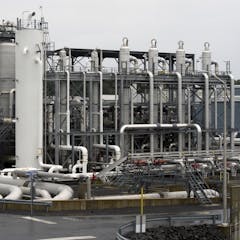
Articles on Methane
Displaying 1 - 20 of 145 articles

Methane is a potent greenhouse gas that can leak from oil and gas wells, pipelines and landfills. Satellites can spot the releases fast enough to get them fixed and help protect the climate.

Knowing which parts of Africa best help to store carbon means funding and policy efforts can be directed to protecting and increasing this carbon ‘land sink’.

Cattle are major producers of methane, a potent greenhouse gas. But there are methods that can reduce their climate impact – if ranchers have incentive to use them.

The US, a minor liquefied natural gas supplier a decade ago, now is the world’s top source. That’s good for energy security, but bad for Earth’s climate. An energy scholar explains the trade-offs.

A new way of measuring emissions may let the biggest polluters evade their responsibility to tackle climate change.

Any efforts to tackle methane emissions must first begin with measuring the intensity of those emissions.

Vaccinating livestock against common disease not only improves animal welfare, it’s good for the planet too.

Undersea ‘fire-ice’ is vulnerable to leaking greenhouse gas, finds new study.

Carbon capture and sequestration can play a role in limiting warming but the nuances of its application are far more complicated than just planting trees. Getting it wrong could make warming worse.

Food systems are increasingly disrupted by climate disasters, while also being a major contributor to climate change. World leaders at COP28 vowed to do something about it.

A veteran of UN climate talks lays out the top themes and their sticking points, including concerns about the host country’s oil interests.

For Australia to shift to a net zero economy, its big polluters need to cut emissions. A get-out clause buried in the policy makes it unlikely that they will, and the result will be devastating.

The Biden administration directed agencies to consider the cost of greenhouse gas emissions in their future purchasing and budget decisions. An example shows just how much is at stake.

The results are intriguing, but analysing the atmospheres of exoplanets is no easy task.

A new report spans more than 300 peer-reviewed studies to present a comprehensive summary of the risks the industry creates for people’s health and wellbeing, as well as for the planet.

The last time methane in the air rose so fast, Greenland warmed by 10°C within decades.

Sydney’s 14 wastewater treatment plants could be modified to also accept food waste, research shows. The ‘anaerobic digestion’ process would produce energy as well as nutrients for reuse.

Regulating greenhouse gas emissions is an important part of Canada’s strategy to achieve net-zero emissions by 2050. However, a newly published study illustrates why enforcing regulation is key.

So much pollution goes into the air today that even without wildfire smoke, 99% of the global population breathes unhealthy air.

LPG meets household needs, is easy to store and transport, and - crucially - is available now in the quantities needed.
